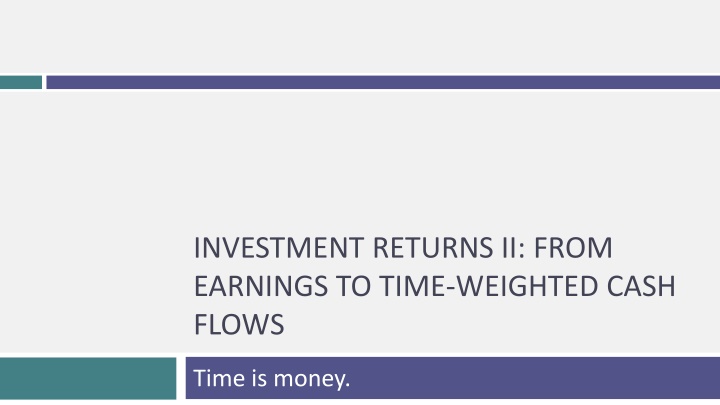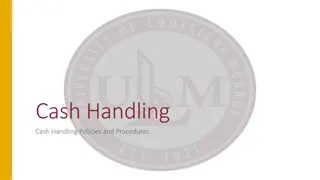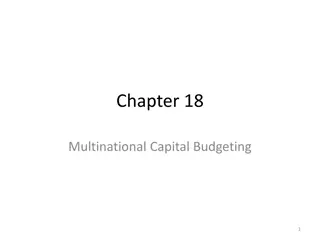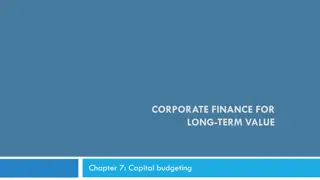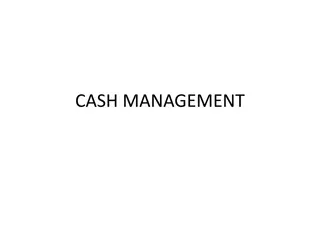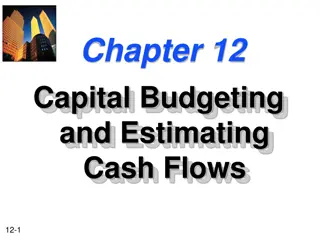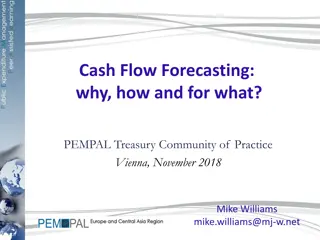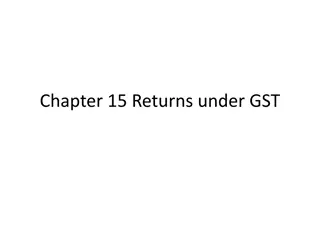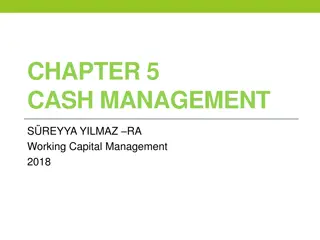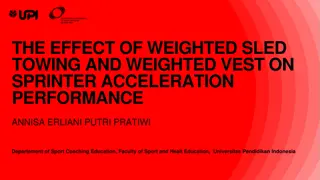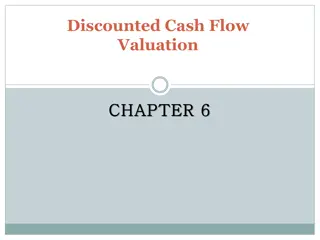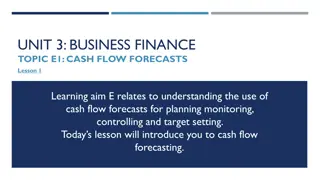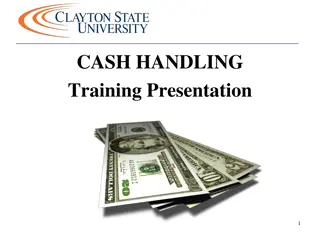Investment Returns II: Time-Weighted Cash Flows
Explore the intricacies of corporate finance, focusing on investment decisions, financing mix, dividend policy, risk assessment, and cost of capital. Dive into detailed analysis and strategies to optimize cash flows and maximize returns.
Download Presentation

Please find below an Image/Link to download the presentation.
The content on the website is provided AS IS for your information and personal use only. It may not be sold, licensed, or shared on other websites without obtaining consent from the author.If you encounter any issues during the download, it is possible that the publisher has removed the file from their server.
You are allowed to download the files provided on this website for personal or commercial use, subject to the condition that they are used lawfully. All files are the property of their respective owners.
The content on the website is provided AS IS for your information and personal use only. It may not be sold, licensed, or shared on other websites without obtaining consent from the author.
E N D
Presentation Transcript
INVESTMENT RETURNS II: FROM EARNINGS TO TIME-WEIGHTED CASH FLOWS Time is money.
Set Up and Objective 1: What is corporate finance 2: The Objective: Utopia and Let Down 3: The Objective: Reality and Reaction The Investment Decision Invest in assets that earn a return greater than the minimum acceptable hurdle rate The Financing Decision Find the right kind of debt for your firm and the right mix of debt and equity to fund your operations The Dividend Decision If you cannot find investments that make your minimum acceptable rate, return the cash to owners of your business Hurdle Rate Financing Mix 4. Define & Measure Risk 5. The Risk free Rate 6. Equity Risk Premiums 7. Country Risk Premiums 8. Regression Betas 9. Beta Fundamentals 10. Bottom-up Betas 11. The "Right" Beta 12. Debt: Measure & Cost 13. Financing Weights Dividend Policy 17. The Trade off 18. Cost of Capital Approach 19. Cost of Capital: Follow up 20. Cost of Capital: Wrap up 21. Alternative Approaches 22. Moving to the optimal 24. Trends & Measures 25. The trade off 26. Assessment 27. Action & Follow up 28. The End Game Financing Type 23. The Right Financing Valuation 29. First steps 30. Cash flows 31. Growth 32. Terminal Value 33. To value per share 34. The value of control 35. Relative Valuation Investment Return 14. Earnings and Cash flows 15. Time Weighting Cash flows 16. Loose Ends 36. Closing Thoughts
Revisiting accounting earnings on Rio Disney Direct expenses: 60% of revenues for theme parks, 75% of revenues for resort properties Allocated G&A: Company G&A allocated to project, based on projected revenues. Two thirds of expense is fixed, rest is variable. Taxes: Based on marginal tax rate of 36.1% 3
The cash flow view of this project.. 0 1 2 3 4 5 6 7 8 9 10 After-tax Operating Income -$32 -$96 -$54 $68 $202 $249 $299 $352 $410 $421 + Depreciation & Amortization $0 $50 $425 $469 $444 $372 $367 $364 $364 $366 $368 - Capital Expenditures $2,500 $1,000 $1,188 $752 $276 $258 $285 $314 $330 $347 $350 - Change in non-cash Work Capital $0 $63 $25 $38 $31 $16 $17 $19 $21 $5 Cashflow to firm ($2,500) ($982) ($921) ($361) $198 $285 $314 $332 $367 $407 $434 added back all non-cash charges such as depreciation. I. 1 2 3 4 5 6 7 8 9 10 Depreciation Tax Bendfits from Depreciation $50 $18 $425 $153 $469 $169 $444 $160 $372 $134 $367 $132 $364 $132 $364 $132 $366 $132 $368 $133 subtracted out the capital expenditures subtracted out the change in non-cash working capital II. III. 4
The incremental cash flows on the project $ 500 million has already been spent & $ 50 million in depreciation will exist anyway 2/3rd of allocated G&A is fixed. Add back this amount (1-t) Tax rate = 36.1% 5
To Time-Weighted Cash Flows Incremental cash flows in the earlier years are worth more than incremental cash flows in later years. In fact, cash flows across time cannot be added up. They have to be brought to the same point in time before aggregation. This process of moving cash flows through time is discounting, when future cash flows are brought to the present compounding, when present cash flows are taken to the future 6
Present Value Mechanics Cash Flow Type 1. Simple CF 2. Annuity Discounting Formula Compounding Formula CFn / (1+r)n CF0 (1+r)n 1 1 - A (1+r)n - 1 (1+r)n r A r 1 - (1+g)n (1+r)n r -g 3. Growing Annuity A(1+g) 4. Perpetuity 5. Growing Perpetuity Expected Cashflow next year/(r-g) A/r 7
Discounted cash flow measures of return Net Present Value (NPV): The net present value is the sum of the present values of all cash flows from the project (including initial investment). NPV = Sum of the present values of all cash flows on the project, including the initial investment, with the cash flows being discounted at the appropriate hurdle rate (cost of capital, if cash flow is cash flow to the firm, and cost of equity, if cash flow is to equity investors) Decision Rule: Accept if NPV > 0 Internal Rate of Return (IRR): The internal rate of return is the discount rate that sets the net present value equal to zero. It is the percentage rate of return, based upon incremental time-weighted cash flows. Decision Rule: Accept if IRR > hurdle rate 8
Closure on Cash Flows In a project with a finite and short life, you would need to compute a salvage value, which is the expected proceeds from selling all of the investment in the project at the end of the project life. In a project with an infinite or very long life, we compute cash flows for a reasonable period, and then compute a terminal value for this project, which is the present value of all cash flows that occur after the estimation period ends.. Assuming the Disney Rio project lasts forever, and that cash flows after year 10 grow 2% (the inflation rate) forever, the present value at the end of year 10 of cash flows after that can be written as: Terminal Value in year 10= CF in year 11/(Cost of Capital - Growth Rate) =715 (1.02) /(.0846-.02) = $ 11,275 million 9
Which yields a NPV of.. Discounted at Rio Disney cost of capital of 8.46% 10
Which makes the argument that.. The project should be accepted. The positive net present value suggests that the project will add value to the firm, and earn a return in excess of the cost of capital. By taking the project, Disney will increase its value as a firm by $3,296 million. 11
The IRR of this project $5,000.00 $4,000.00 $3,000.00 $2,000.00 Internal Rate of Return=12.60% $1,000.00 NPV $0.00 8% 9% 10% 11% 12% 13% 14% 15% 16% 17% 18% 19% 20% 21% 22% 23% 24% 25% 26% 27% 28% 29% 30% -$1,000.00 -$2,000.00 -$3,000.00 Discount Rate 12
The IRR suggests.. The project is a good one. Using time-weighted, incremental cash flows, this project provides a return of 12.60%. This is greater than the cost of capital of 8.46%. The IRR and the NPV will yield similar results most of the time, though they sometimes can yield different results, especially when comparing projects: A project can have only one NPV, whereas it can have more than one IRR. The NPV is a dollar surplus value, whereas the IRR is a percentage measure of return. The NPV is therefore likely to be larger for large scale projects, while the IRR is higher for small-scale projects. The NPV assumes that intermediate cash flows get reinvested at the hurdle rate , which is based upon what you can make on investments of comparable risk, while the IRR assumes that intermediate cash flows get reinvested at the IRR . 13
Task Read Chapter 5 Describe a typical investment for your company 14
